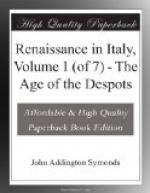the bourgeois classes a self-satisfied positivism,
vividly portrayed in the person of Cosimo de’
Medici, superseded the passions and enthusiasms of
a previous age. Thus force, craft, and practical
materialism formed the basis of Italian immorality.
Vehement contention in the sphere of politics, restless
speculation, together with the loosening of every tie
that bound society together in the Middle Ages, emancipated
personality and substituted the freedom of self-centered
vigor and virility (Virtu) for the prescriptions of
civil or religions order. In the nation that had
shaken off both Papal and Imperial authority no conception
of law remained to control caprice. Instead of
law men obeyed the instincts of their several characters,
swayed by artistic taste or tyrannous appetite, or
by the splendid heroism of extinct antiquity.
The Church had alienated the people from true piety.
Yet no new form of religious belief arose; and partly
through respect for the past, partly through the convenience
of clinging to existing institutions, Catholicism was
indulgently tolerated. At the same time the humanists
introduced an ideal antagonistic to Christianity of
the monastic type. Without abruptly severing
themselves from the communion of the Church, and while
in form at least observing all its ordinances, they
thought, wrote, spoke, felt, and acted like Pagans.
To the hypocrisies of obsolete asceticism were added
the affectations of anachronistic license. Meanwhile,
the national genius for art attained its fullest development,
simultaneously with the decay of faith, the extinction
of political liberty, and the anarchy of ethics.
So strong was the aesthetic impulse that it seemed
for a while capable of drawing all the forces of the
nation to itself. A society that rested upon force
and fraud, corroded with cynicism, cankered with hypocrisy
recognizing no standard apart from success in action
and beauty in form, so conscious of its own corruption
that it produced no satirist among the many who laughed
lightly at its vices, wore the external aspect of exquisite
refinement, and was delicately sensitive to every
discord. Those who understood the contradictions
of the age most deeply were the least capable of rising
above them Consequently we obtain in Machiavelli’s
works the ideal picture of personal character, moving
to calculated ends by scientifically selected means,
none of which are sanctioned by the unwritten code
of law that governs human progress. Cosimo’s
positivism is reduced to theory. Fraud becomes
a rule of conduct. Force is advocated, when the
dagger or the poisoned draught or the extermination
of a city may lead the individual straight forward
to his object. Religion is shown to be a political
engine. Hypocrisy is a mask that must be worn.
The sanctities of ancient use and custom controlling
appetite have no place assigned them in the system.
Action is analyzed as a branch of the fine arts; and
the spirit of the age, of which the philosopher makes
himself the hierophant, compels him to portray it as
a sinister and evil art.




